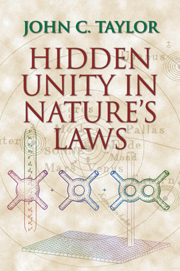Book contents
- Frontmatter
- Contents
- Preface
- 1 Motion on Earth and in the Heavens
- 2 Energy, Heat and Chance
- 3 Electricity and Magnetism
- 4 Light
- 5 Space and Time
- 6 Least Action
- 7 Gravitation and Curved Spacetime
- 8 The Quantum Revolution
- 9 Quantum Theory with Special Relativity
- 10 Order Breaks Symmetry
- 11 Quarks and What Holds Them Together
- 12 Unifying Weak Forces with QED
- 13 Gravitation Plus Quantum Theory – Stars and Black Holes
- 14 Particles, Symmetries and the Universe
- 15 Queries
- APPENDIX A The Inverse-Square Law
- APPENDIX B Vectors and Complex Numbers
- APPENDIX C Brownian Motion
- APPENDIX D Units
- Glossary
- Bibliography
- Index
6 - Least Action
Published online by Cambridge University Press: 20 January 2010
- Frontmatter
- Contents
- Preface
- 1 Motion on Earth and in the Heavens
- 2 Energy, Heat and Chance
- 3 Electricity and Magnetism
- 4 Light
- 5 Space and Time
- 6 Least Action
- 7 Gravitation and Curved Spacetime
- 8 The Quantum Revolution
- 9 Quantum Theory with Special Relativity
- 10 Order Breaks Symmetry
- 11 Quarks and What Holds Them Together
- 12 Unifying Weak Forces with QED
- 13 Gravitation Plus Quantum Theory – Stars and Black Holes
- 14 Particles, Symmetries and the Universe
- 15 Queries
- APPENDIX A The Inverse-Square Law
- APPENDIX B Vectors and Complex Numbers
- APPENDIX C Brownian Motion
- APPENDIX D Units
- Glossary
- Bibliography
- Index
Summary
What This Chapter Is About
The titles of most of the chapters in this book convey, I hope, something to the reader. The title of this chapter is an exception. The idea that there is a quantity called action, which takes its least value when the equations of motion are obeyed, is now one of the foundations of classical (as opposed to quantum) physics, and even in quantum physics the action is a basic quantity. This idea is not easily expressed in everyday terms, but I think I would be guilty of some sort of distortion if I omitted it from this book. So what is it all about?
In Section 4.4, I explained Fermat's principle of least time as applied to light rays. The principle says that the path taken by a light ray between two given points is such as to make the time taken by the light a minimum. The principle of least action is an extension of this sort of idea to the motion of particles or to any other timevarying system, like the electromagnetic field. The difference from the case of light is that it is now not just the time that is a minimum, but some less obvious quantity, called action. One needs some rule to decide what the action is for a given system. This rule, indirectly, defines the forces operating in the system.
I will use the word least throughout, but as I will explain in Section 6.3, this is not quite accurate. In some cases, we need a property a little more general than being least (i.e., minimum), that is, the property of being stationary.
- Type
- Chapter
- Information
- Hidden Unity in Nature's Laws , pp. 175 - 190Publisher: Cambridge University PressPrint publication year: 2001



